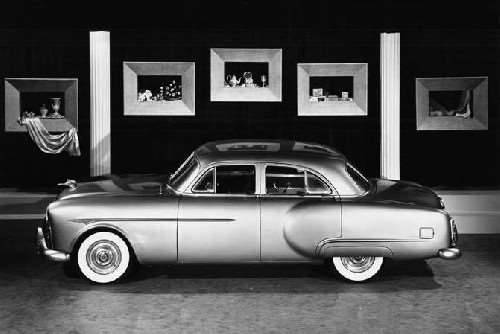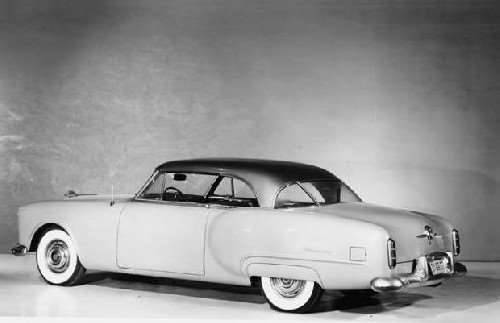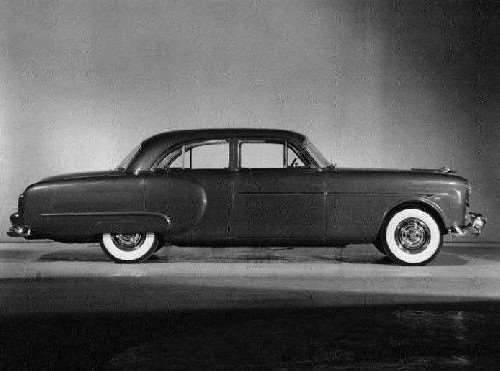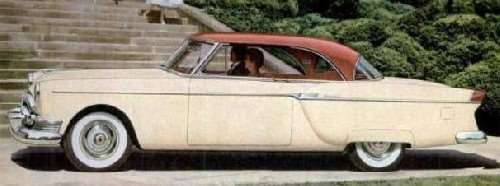|
Re: Packard Seniors 1940-56
|
||||
|---|---|---|---|---|
|
Home away from home

|
Good point, Jim. I recall reading that Cadillac's engine was carryover from 1953 to 1954 yet the HP jumped from 210 to 235, done deliberately so Cadillac could have something to crow about for 1954. To the extent that perception was reality back then, the manufacturers' published numbers were important.
As Steve has suggested, a V8 in 1953 would have been much better than continuing any of the Eights and an opportune time given that year's styling refresh. That Packard had considered such an intro date then nixed it is unfortunate. I can sort of see why the company might have been squeamish given the major cash outlay it made to develop Ultramatic but then again, there would have been four years between them. Back to the chicken/egg... Packard needed profits to invest in such technologies but couldn't generate them because it didn't have such technologies on the road. At a minimum I think Packard should have kept it's 356 in service from 1951-54 and lightened it with an aluminum head. The fact that Packard dropped its 356 for 1951 only to have to create a one-year only 359 with 9 main bearings and an aluminum head for 1954 speaks to its planning shortsightedness. The only four years that Packard was deficient to Cadillac in horsepower between 1940-56 was from 1951-54. The 356 would have cut that deficit by at least two years and possibly three unless Cadillac had chosen to publish 235 HP in 1953, which they might well have done to beat Packard. Next up, body design... an area that presented Packard with ample opportunity to earn cash and make it a two horse race with Cadillac.
Posted on: 2015/5/8 17:23
|
|||
|
||||
|
Re: Packard Seniors 1940-56
|
||||
|---|---|---|---|---|
|
Home away from home

|
Am not sure history has recorded the tremendous opportunity that lay before Packard as it set out to craft its 1951 models. The company may not have realized it (though it should have!) but beginning in 1951 it could have gone toe-to-toe with Cadillac and greatly increased its financial health in the process. The two elements were interdependent. Packard was about luxury cars. No luxury cars, no Packard. For 1951 the task was not simply to chase Cadillac's 60 Special and 75, it was to get out of the rat race started with the necessary-at-the-time One Twenty and get back to making pure luxury cars. Like in the 1920s this meant offering a respectable luxury entry that generated most of the volume, and carefully building on its underpinnings to fill out the showroom with all the good stuff expected from the best-of-the-best.
Size mattered in the 1951 luxury market. So did pricing, power and styling. Tables 1 and 2 make it clear that Packard's 400 Patrician was not competitive with 60 Special in the first three categories and I would argue that styling could have been better too. The Patrician's luxurious and roomy interior alone was not enough to carry the day, the top sedan needed to be long, handsome and elegant, the King of the Road. Before we start adding inches to the 1951-4 models, a point about Packard body styling. In the company's heyday the body elements (windshield, backlight, C- and D-pillar shape, decklids) were largely common from entry through top models excepting customs. The only changes were in door, roof and hood length. The grill was also common. I like this strategy because it gave Packard one voice. You bought a Packard, you got a Packard. A luxurious Packard. Let's use it again. As with the '56 work-up I will use the body styling details that Packard had created, reworking only their dimensions and application. As Steve knows, I don't like broken surfaces and glass mullions so you largely won't see them in the work ups. When GM opened the Fifties it opened up its greenhouses in the C-bodies with slender pillars and lots of glass. This signaled modernity. For Packard the most slender 1951 C-pillar was the 200's, which also visually pulled the greenhouse back whereas the 300/400's pushed it a bit forward and made the rear roof look a bit tall and heavy. The 200's backlight was also of clean one piece design with no mullions. For these reasons and the goal of establishing one common Packard sedan "look" I use it for all Packard sedans. The 200 sedan had good hood/roof/decklid proportions so the only change I would have made would have been removal of body insert between the front and rear doors. Hudson did this for 1948 so no excuses Packard! The big changes to the 200 would have been in the interior, which would been of 300 quality including broadcloth, and the price, which would have been several hundred dollars higher than the actual 200 or around $2,900. I would have also reworked the grill; more on that in next post on the 1953-54 cars. Powering the 200 would have been the 288 Eight. Maybe the series could have been called simply the Eight or perhaps the 200 Eight Clipper. There would have been no 200 coupe, that tooling capital better spent on one line of spectacular 2-door cars, the former 250 hardtop coupe and convertible. These would have become the 300 or 300 Super Eight Victoria series running with the 327 Eight. They would not have been as tall as what came to be, instead lowered two inches forward of the decklid and rear fenders, both of which would have been carried over from the 200 sedan. I ragged on such lowering in a previous post but alas, here it is. Two inches wouldn't have been that detrimental to seating comfort, would it? Would have done wonders to the proportions. The cars would have sat on the 200 sedan's 122 inch chassis with the windshield moved back a few inches to sinc up with the move rearward of the lowered front seats and I/P. I have shown this work-up before but will do so again for the benefit of those who haven't seen it. Finally the 400 or 400 Custom Eight Patrician in all its bafflegab, with 356 Eight under hood. Sitting on a 132 inch wheelbase it would have had same greenhouse length and rear legroom as actual Patrician but now with doors 2-1/2 inches longer. I recall comments made in this forum that rear ingress/egress in Packard Contour sedans could have been better, so the longer rear doors would have served a functional purpose as well as giving the car the appearance of greater length. Increases of 5 inches to hood and rear overhang/decklid would have completed the Patrician's transformation. Key to investment affordability would have been to shape the Patrician's front fenders, hood, door panels and decklid such that its tooling could be used to stamp the shorter panels used in the 200 sedan. The Contour's side panels appear to curve into the body as they move rearward, which would have presented a problem for this strategy but I offer it because the Executive limo somehow visually gets away with rear doors that add an extra 27 inches to the 200 coupe's body length while not looking like the surface loses it tangent. Will talk about limos and volumes/pricing/profits in the 1953-54 post. For those still with me, thanks for hanging in there! As usual, all thoughts welcome.
Posted on: 2015/5/8 19:53
|
|||
|
||||
|
Re: Packard Seniors 1940-56
|
||||
|---|---|---|---|---|
|
Home away from home

|
Okay, onto 1953-54 and again the use of 200's roof and backlight, now a one-piece wrapped affair fully caught up with Cadillac's open airy look. Let's not let its similarity to backlights such as Jet stops us! I love the look and think it and the new surfacing at windshield transformed the Clipper this year.
The sore thumb taillights introduced for 1954 also needed to happen in 1953 (1955 would have then seen cathedrals across the board or perhaps the '56 boomerangs, the cathedrals used exclusively for the Caribbean 2 and 4 door hardtops before becoming mainstream for '57; think '55 Eldorado fins and how Cadillac morphed them into mainstream). The Eight Clipper sedan would have otherwise been carryover save for a bump in 288's horsepower or intro of the smallest version of the much needed V8. Also upgrades to Ultramatic. The Super Eight Victoria coupe/convertible would have followed suit, and gotten a one piece backlight this year instead of waiting until 1954. The Custom Eight Patrician and limos would have rounded out the field, all picking up the design changes. Speaking of limos, Packard certainly could have gone ahead and had Henney make an 8-pass limo, a "600" series. Because it likely would have sold poorly due to its high price, I would have also pursued a 6-pass model for the modern executive, a "500 Executive" lest they missed the point! To keep investment low Packard could have simply cut the 400's roof and floorpan at B-pillar and added a 5 inch section. With division window and other niceties Packard could have created a desirable car that Cadillac did not offer, built at EGB, priced at or below the 75 and with extras like leather covered formal roof with small backlight available upon request. I show a Clipper with modified grill next to each sedan image to give you an idea of what I had in mind up front. Packard's Contour grill looked modern and is quite captivating when shiny and bright and I don't begrudge it, but I do think Packard could have made a grill that was more tailored and had a commanding, stand-up-and-salute presence about it in keeping with Packard tradition. Not a vertical grill though, rather something in between vertical and Contour. Look at European sports cars of the early to mid-fifties such as Maserati and Talbot Lago, very defined and together rather than American mishmash of metal. For 1953 the grill's lower horizontal bars could have wrapped around the fender as shown, for freshness up front versus 1951-52's otherwise similar grill. Am not a fan of the clash of metal in the Request and Robin Jones' wonderful renderings. But hey, these might have been just fine and much better than my proposal. The importance of a good looking grill on a Packard, more so than on a Cadillac, cannot be overstated. The reason I show all these models and a strategic shift on Packard's part to a pure luxury line-up is the profit potential. Had Packard sold 50,000 200 sedans in 1953 that were not priced from $2,588 to $2,735 but rather started at $3,000, the additional markup of around $100 would have net the company an additional $5 million. Question is, could the same high volumes have been generated? We'll never know but we do know much about brands and pricing and perceived value. An entry Packard with the right body details, the right grill, the right interior, the right dealer service, the right marketing and the right big brothers in the showroom could have done wonders. The potential was always there, had just sat dormant for many years. Now let's look at the Patrician's earning potential. With a long flowing body and compelling grill it could have justified an additional $500 in price, putting it right up there with 60 Special. But the additional material cost to add those extra inches and 356 engine would have only cost around $200-$250. Assuming the car generated the same 7,456 sales as actual, the extra profit would have yielded an additional $2 million. Same shot in the arm for low-slung Victoria models though these would likely have seen an increase in price and volume given their dynamic proportions. Paul EDIT: Forgot about an Ionia wagon. Absolutely, beginning with the 1951 models and probably in the 200 series though could have been a unique 250 series 3-row that used the Patrician's longer doors for extra legroom and its own 127 inch wheelbase.
Posted on: 2015/5/8 21:05
|
|||
|
||||
|
Re: Packard Seniors 1940-56
|
||||
|---|---|---|---|---|
|
Forum Ambassador

|
Heck, Packard couldn't even make up their mind when planning the 24th series about including the hardtop and convertible, it was a on-again, off-again decision. And when they finally gave it the go, it initially was bottom of the line (200) vehicle before some light bulb went on they quickly moved it up a notch to a 250. What does that say about their thinking - a luxury maker without a hardtop or convertible, and when they do go ahead neither is a top-line vehicle? Just astounds the mind! Lots of details on this topic in the Bob Neal book.
Posted on: 2015/5/8 22:26
|
|||
|
||||
|
Re: Packard Seniors 1940-56
|
||||
|---|---|---|---|---|
|
Home away from home

|
It sounds like Ferry and his Board had investmentphobia. They couldn't figure out how to make Packard tick like it had in the old days so they spent money only when pressed. For a car company that's a dangerous game. Initiative drives profits, not making like a squirrel and burying the company's nuts.
Am trying to imagine what would have become of Packard in the early Twenties had these folks been running it. "Our only viable car is the new Six so let's keep making it in shorty short wheelbase form and make a 5 inch longer body for our new top-of-line flagship, also powered by the Six." And when the occasional off-the-wall suggestion to, hah? what? make a straight Eight??!!! came up, the sensible people in the room would say: "Why would we want to do that? That sounds too risky. No no no, we can't afford that, and who would buy it anyway? We need to guard our diminishing cash. No, let's just stay the course and see what everyone else does, and hope they don't do too much." And with that Packard would have become an historical blip. Blip blop bloop.
Posted on: 2015/5/9 15:50
|
|||
|
||||
|
Re: Packard Seniors 1940-56
|
||||
|---|---|---|---|---|
|
Home away from home

|
<i>Am trying to imagine what would have become of Packard in the early Twenties had these folks been running it. "Our only viable car is the new Six so let's keep making it in shorty short wheelbase form and make a 5 inch longer body for our new top-of-line flagship, also powered by the Six."</i>
Chrysler was run by beancounters through the 60s and 70s. Did not do anything new and different. If they weren't making enough profit, they just used cheaper materials and allowed sloppier production tolerances. I'm amazed the Omnirizon made it to production, instead of a truncated, stripper Duster based knockoff of the Gremlin. Iacocca perked the place up a bit with the minivan, a concept his crew reportedly brought form Ford, and the ragtop LeBaron, but the company soon slid back to the cheap and conventional. Best thing Iacocca did was buy AMC to get Jeep. FCA now sells more Jeeps than any other brand. The company I worked for in the late 70s was on it's second generation of management after the founders died. Their bread and butter product, end face mechanical seals for API and ANSI pumps, was little changed from it's product of 40 years earlier, and it's advertising pitch was "a perfectly acceptable solution". It's younger competitors were innovating circles around it, offering better performance at lower cost. The company's response was to hire cheaper machinists and keep using decades old machine tools to keep costs down. That company was bought out in 94, the headquarters was moved to Houston, and the old management was not invited to make the move. That is probably the trend throughout corporations. After the founders, the people with vision, pass from the scene, they are replaced by people increasingly disinterested in the products and more interested in staying in their comfort zone.
Posted on: 2015/5/9 17:56
|
|||
|
||||
|
Re: Packard Seniors 1940-56
|
||||
|---|---|---|---|---|
|
Home away from home

|
Hi Paul
"At a minimum I think Packard should have kept it's 356 in service from 1951-54 and lightened it with an aluminum head. The fact that Packard dropped its 356 for 1951 only to have to create a one-year only 359 with 9 main bearings and an aluminum head for 1954 speaks to its planning shortsightedness." While the 356 ci was old technology costly to manufacture installed only in the Custom Eight decidedly failing against the competition, the reasons for its discontinuance, the option to create larger displacement engines from the 288/327 block always existed, demonstrated by their 359. Simply going to 4 1/2 inch stroke, retaining the 3 1/2 bore, yields 346 ci.. No reason not to go for the 4 5/8 stroke for a new generation 356 when developing the '51 nine main bearing unit. This reveals the bi-polar approach to 24th Series product planning. From Neal, I understand the fixation on the low-budget volume segment that was their main focus. As such, they seem confused and indecisive how to create the upper series models. Yet here we have them spending to create a special block and crankshaft for the Patrician only then not even get promotional benefits from the effort. Few Packard customers knew of or understood the advantages of nine main bearing over five. Being identical displacements, it also suggested the five main 327 ci unit was only a good engine but not their best. Doubtful anyone who drove a 300/Cavalier then a Patrician 400 could perceive any difference in operational smoothness. Moving upmarket for their basic 200 Eight Clipper the 327 ci should have been the standard engine, the 288 retained for export or Canadian markets only. But buyers would quickly understand the larger displacement, higher torque engine upon acceleration, he'd feel it . While they were still dependent upon L-head straight eights, they should have utilized the great advantage those had: low rpm/high torque. Horsepower ratings look great in advertisements, but torque moves the car. Customers trying out a '51 Cadillac 62 sedan with its 312 lb/ft @ 1800 rpm then a '51 Patrician's 275 lb/ft @ 2000 rpm both with slushy automatics could instantly perceive the difference. Increasing to 8.0 compression ratio as soon as possible would help too. At least until an OHV V8 became available, this would have given the Packard driver a fighting chance in the stoplight drags. Proportioning and models looks great, more comments to come. Steve
Posted on: 2015/5/9 17:57
|
|||
|
.....epigram time.....
Proud 1953 Clipper Deluxe owner. Thinking about my next Packard, want a Clipper Deluxe Eight, manual shift with overdrive. |
||||
|
||||
|
Re: Packard Seniors 1940-56
|
||||
|---|---|---|---|---|
|
Home away from home

|
"After the founders... pass from the scene, they are replaced by people increasingly disinterested in the products and more interested in staying in their comfort zone."
Exactly.
Posted on: 2015/5/9 21:02
|
|||
|
||||
|
Re: Packard Seniors 1940-56
|
||||
|---|---|---|---|---|
|
Home away from home

|
"...the option to create larger displacement engines from the 288/327 block always existed..."
Great point Steve, I see your logic on it and your other comments including the 288 not being the best choice for the 200 Eight Clipper trying to be an entry luxury car. Maybe for the 300 Super Eight Victoria the 327 could have gotten a 4-barrel carb in 1951 to set it apart from the 200? I don't know the history of 4-barrel technology. Why didn't Cadillac do it until 1952 and Packard, 1953?
Posted on: 2015/5/9 21:11
|
|||
|
||||

 (34.47 KB)
(34.47 KB)













